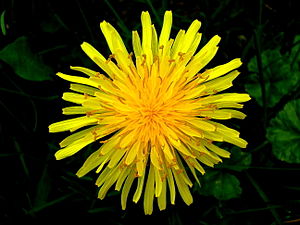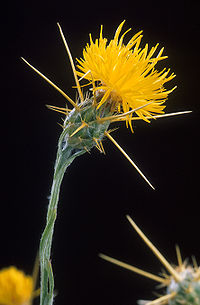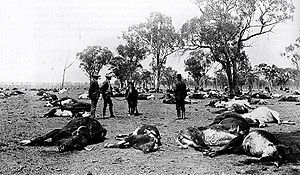
Weed
Background to the schools Wikipedia
This content from Wikipedia has been selected by SOS Children for suitability in schools around the world. SOS Children works in 45 African countries; can you help a child in Africa?

A weed in a general sense is a plant that is considered by the user of the term to be a nuisance, and normally applied to unwanted plants in human-made settings such as gardens, lawns or agricultural areas, but also in parks, woods and other natural areas. More specifically, the term is often used to describe native or nonnative plants that grow and reproduce aggressively.
Weeds may be unwanted because they are unsightly, or they limit the growth of other plants by blocking light or using up nutrients from the soil. They also can harbour and spread plant pathogens that can infect and degrade the quality of crop or horticultural plants. Weeds may be a nuisance because they have thorns or prickles, cause skin irritation when contacted, or parts of the plants might come off and attach to fur or clothes.
Definition
The term weed in its general sense is a subjective one, without any classification value, since a "weed" is not a weed when growing where it belongs or is wanted. Indeed, a number of "weeds" have been used in gardens or other cultivated-plant settings. An example is the corncockle, Agrostemma, which was a common field weed exported from Europe along with wheat, but now sometimes grown as a garden plant.
Distribution

Weedy plants generally share similar adaptations that give them advantages and allow them to proliferate in disturbed environments whose soil or natural vegetative cover has been damaged. Naturally occurring disturbed environments include dunes and other windswept areas with shifting soils, alluvial flood plains, river banks and deltas, and areas that are often burned. Since human agricultural practices often mimic these natural environments where weedy species have evolved, weeds have adapted to grow and proliferate in human-disturbed areas such as agricultural fields, lawns, roadsides, and construction sites.
The weedy nature of these species often gives them an advantage over more desirable crop species because they often grow quickly and reproduce quickly, have seeds that persist in the soil seed bank for many years, or have short lifespans with multiple generations in the same growing season. Perennial weeds often have underground stems that spread out under the soil surface or, like ground ivy ( Glechoma hederacea), have creeping stems that root and spread out over the ground. A number of weedy species have developed allelopathy, chemical means to prevent the germination or growth of neighboring plants.
Relation to humans
As long as humans have cultivated plants, weeds have been a problem. Weeds have even been mentioned in religious and literature texts like the following quotes from Genesis and a Shakespearean sonnet:
"Cursed is the ground because of you; through painful toil you will eat of it all the days of your life. It will produce thorns and thistles for you, and you will eat the plants of the field. By the sweat of your brow you will eat your food until you return to the ground,"
"To thy fair flower add the rank smell of weeds: But why thy odour matcheth not thy show, The soil is this, that thou dost common grow."
Weed seeds are often collected and transported with crops after the harvesting of grains, and so many weed species have moved out of their natural geographic locations and have spread around the world with humans. (See Invasive species.) Not all weeds have the same ability to damage crops and horticultural plants. Some have been classified as noxious weeds because if left unchecked, they often dominate the environment where crop plants are to be grown.
. They are often foreign species mistakenly or accidentally imported into a region where there are few natural controls to limit their spread and population. Many weeds have ideal areas for growth and reproduction thanks to large areas of open soil created by the conversion of land to agriculture, and human distribution of food crops mixed with seeds of weeds from other parts of the world. Thus humans are the vector of transport and the producer of disturbed environments, so weedy species have an ideal association with humans.
A number of weeds, such as the dandelion Taraxacum, are edible, and their leaves and roots may be used for food or herbal medicine. Burdock is common weed over much of the world, and is sometimes used to make soup and other medicine in East Asia. These so-called " beneficial weeds" may have other beneficial effects, such as drawing away the attacks of crop-destroying insects, but often are breeding grounds for insects and pathogens that attack other plants. Dandelions are one of several species which break up hardpan in overly cultivated fields, helping crops grow deeper root systems. Some modern species of domesticated flower actually originated as weeds in cultivated fields and have been bred by people into garden plants for their flowers or foliage.
Examples
- Bindweed
- Broadleaf plantain - perennial, spreads by seeds that persist in the soil for many years
- Burdock - biennial
- Creeping Charlie - perennial, fast-spreading plants with long creeping stems
- Dandelion - perennial, wind-spread, fast-growing, and drought-tolerant
- Goldenrod - perennial
- Japanese Knotweed
- Kudzu - perennial
- Leafy spurge - perennial, with underground stems
- Milk thistle - annual or biennial
- Poison ivy - perennial
- Ragweed - annual
- Sorrel - annual
- Sumac - woody perennial
- Wild carrot - biennial
- Wood sorrel - perennial


